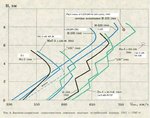An issue raised above the shape of Jumo 213 power curve, both here and at Tony Williams' forum, made me dwell a bit about things mentioned in the title. Like I need any pretext...
One member in each forum commented that power curve should begin, for a choosen power setting, from, say, 1500 HP, and increase until the full throttle height (say, 1600 HP at that altitude). The power curves for the Jumo 213 engines (all of them) 'behave' different - they start from, say, 1700 HP and than slowly decline until full throttle height, then power sharply declines until the supercharger engages next speed. The members commented that power graphs were Jumo's fabrications, since they defy laws of physics.
At the graph attached, the power for a chosen setting (Steig Kampfleistung) starts from 1600 PS, falling just a bit until the 1st full throttle height is reached (circled, at around 2 km), then sharply falling until supercharger is in second gear (at about 2.5 km), then again slightly falling until ~5.5 km (circled, 2nd full throttle height). The members argued that, for same setting, the powers should started from lower values, depicted here with red lines.

At Tony's forum, another member explained the matter (here, last post):
At yet another forum (AEHS forum, here, last post), it was stated this:
So I started some digging...
One member in each forum commented that power curve should begin, for a choosen power setting, from, say, 1500 HP, and increase until the full throttle height (say, 1600 HP at that altitude). The power curves for the Jumo 213 engines (all of them) 'behave' different - they start from, say, 1700 HP and than slowly decline until full throttle height, then power sharply declines until the supercharger engages next speed. The members commented that power graphs were Jumo's fabrications, since they defy laws of physics.
At the graph attached, the power for a chosen setting (Steig Kampfleistung) starts from 1600 PS, falling just a bit until the 1st full throttle height is reached (circled, at around 2 km), then sharply falling until supercharger is in second gear (at about 2.5 km), then again slightly falling until ~5.5 km (circled, 2nd full throttle height). The members argued that, for same setting, the powers should started from lower values, depicted here with red lines.
At Tony's forum, another member explained the matter (here, last post):
The 213 had an elaborate variable air inlet comprising "a fan-like series of eleven blades mounted in the supercharger inlet casing ... These blades movable about their axis, the movement being automatically controlled."
At yet another forum (AEHS forum, here, last post), it was stated this:
BTW, any update on the status of the Russian Piston Engine book? I hope it has ample coverage of Mikulin´s AM series. Not only it is the only series produced aero engine of the time with variable geometry blower inlet with the Jumo 213 (the latter copied the former), it seems also to be the only series produced DOHC aero engine of the war.
So I started some digging...



